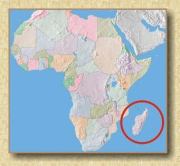Two Thursdays ago I had finished teaching a lesson and was headed home when a man and woman met me at the classroom door. The woman, Pauline, who was in her late twenties and wore nice jean pants, told me they had come from the village’s Anglican church for my help. They needed someone to transcribe some English gospel songs so the church’s choir could sing them accurately. “I know some English,” she said, “But I’m not fluent. Can you come with us and help us?” Sure, I said.
We took a taxi to the other side of town and were soon sitting on reed mats in the woman’s home. We drank cold soft drinks and listened to “It is Jesus” over and over on a CD player. As with many instances here in Madagascar, I felt ill-equipped to help because I’m awful at discerning words from songs. I once thought a lyric in Jimi Hendrix’s “Purple Haze” was, “Excuse me while I kiss this guy,” instead of, “Excuse me while I kiss the sky.” I tried my best, though, until I suggested that I’d look up the lyrics on the Internet the next time I was in Sambava. “Great idea!” Pauline said. Then she invited me to church, and with how pleasant her demeanor was, I accepted. I thought the outing would be good for Mr. Jordan publicity.
That Sunday Pauline and I walked together to the front of the church. The entire congregation, about 300 people, stared at me and whispered as we sat down on the choirs’ benches. I wasn’t bothered by the attention; the commotion of being a white man in a Malagasy village, while unsettling in theory, becomes surprisingly pedestrian after a few months. Pauline turned to me and said, “My father’s the pastor, and he wants to introduce you. Is that O.K.?” I nodded and told her I’d even give a speech if the pastor wanted.
Hornet nests and remnants of old ones dotted the church’s walls, and the eight o’clock sunlight streamed through the paneless windows. Behind the pulpit was a painting of an ocean and trees created most likely by a middle school student. In the painting’s sky was a cross formed by four florescent lights which would be illuminated at the service’s end to celebrate the glory of God. Some worshippers wore proper church clothes that day, but the majority had on t-shirts and flip-flops, and many women wore white veils of varying patterns. Sweat already dripped down our backs from the humidity.
The service began with a song. I stood with the choir but did not join them in singing the English song, “Mama, I Learned a Lesson.” Later I asked Pauline why the choir sang English songs when the rest of the service was in Malagasy, and I think she said the songs served as a symbolic institutional tie to the Anglican Church in the United Kingdom. After the song we sat again and the pastor took to the pulpit. He said some things I didn’t understand, the congregation laughed at the things, and then he said my name. I awkwardly walked to the pulpit and stood beside the pastor as he said more things. Then he asked me to announce my name and hometown. I did. A few snickers from below. The pastor said more things and made a gesture for me to begin my speech. I took a deep breath and, in Sakalava, I said:
“Hello. This is my first speech. Before I begin my speech, I need to say, ‘I’m sorry.’ I still don’t know how to speak Sakalava. Learning Sakalava is difficult. My name is Jordan. I’m from America. Some of my students are here today. I work with the Peace Corps, which is an American governmental organization. I teach English at the middle school without money. Malagasy people do not pay me, the Peace Corps pays me. I will live here for two years, and I…” Here I sputtered like a dolt for a while and tried to find the right words to say. “I’ll do other work, too. I will build a library here in the village. I’m your friend. If you see me walking in the street, you should talk with me. If you want to practice speaking English, I’ll practice with you. That’s it. Thanks.”
The congregation applauded and I returned to my seat, thinking of all the jokes and correct grammar I had planned to use but didn’t. I knew the speech was terrible, but I wanted to show the congregation I was making an effort to learn their language and be a part of their community. In the few months I’ve been here, I’ve gathered that there are two halves to the Peace Corps. The first half is your assigned job of teaching or administering immunizations or helping small businesses or whatever. The other half is creating relationships with your neighbors, your colleagues, your community, because it sends the powerful image that despite the fact you are you and they are they and there’s half a world of cultural differences among everyone involved, we can love each other as brothers.



 Posted by Jordan Butler
Posted by Jordan Butler 


